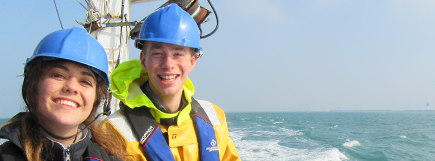Water Levels and Flow
Code UE : HBB340
- Cours + travaux pratiques
- 3 crédits
- Volume horaire de référence
(+ ou - 10%) : 30 heures
Responsable(s)
Claire MARION
Objectifs pédagogiques
Module Outline:
Description of the forces generating tides (static and dynamic theory).
Description of the major harmonic constituents. Identification and recognition of the different types of tides.
Explanation of the concept of amphidromic points and cotidal charts.
Definition of the different tidal levels.
Explanation of the working principles of different types of water level gauges and poles. Describe the characteristics of river, coastal and offshore water level gauges. Description of the installation and operation of water level gauges and poles
Description of the relation between flow and tides. Definition of rectilinear and rotary tidal streams and related elements. Field measurements for tidal flow and currents, including log ship, pole and current meters.
Prediction of water levels for main and secondary ports, using tide tables. Calculate water level at a particular time, and/or calculate the time at which a specific height will occur.
Application of cotidal chart information.
Compute tidal predictions using numerical models.
Description of the temporal and spatial effects on water level caused by: atmospheric pressure, wind, seiches, and precipitation. Identification of water level variations occurring in rivers and lakes and due to dam operations.
Publications & Case studies
Description of the forces generating tides (static and dynamic theory).
Description of the major harmonic constituents. Identification and recognition of the different types of tides.
Explanation of the concept of amphidromic points and cotidal charts.
Definition of the different tidal levels.
Explanation of the working principles of different types of water level gauges and poles. Describe the characteristics of river, coastal and offshore water level gauges. Description of the installation and operation of water level gauges and poles
Description of the relation between flow and tides. Definition of rectilinear and rotary tidal streams and related elements. Field measurements for tidal flow and currents, including log ship, pole and current meters.
Prediction of water levels for main and secondary ports, using tide tables. Calculate water level at a particular time, and/or calculate the time at which a specific height will occur.
Application of cotidal chart information.
Compute tidal predictions using numerical models.
Description of the temporal and spatial effects on water level caused by: atmospheric pressure, wind, seiches, and precipitation. Identification of water level variations occurring in rivers and lakes and due to dam operations.
Publications & Case studies
Compétences visées
Learning Outcomes:
Fundamental knowledge of tides, tide prediction and use of in the information obtained.
Knowledge about tidal fundamentals and their origin, the use of data and information.
Fundamental knowledge of tides, tide prediction and use of in the information obtained.
Knowledge about tidal fundamentals and their origin, the use of data and information.
Contenu
Lecture 1 – General introduction and principal water level variation
General introduction wave theory
Water level variations (waves, storm surges, fresh water discharge, seiches, tsunamis, tides)
Case safety against flooding (s-plan, d-plan)
Tide generating forces
Temporal variations of tides
Classification of tides
Lecture 2 – Estuaries
Connection between rivers and oceans/seas
Introduction in sediment transport
Introduction in river morphology
Processes determining tidal propagation in estuaries
Currents, salt intrusion and sediments in estuaries
Case Schelde estuary
Lecture 3 – Hydrometric measurements
Different techniques to measure water levels
Datum control, benchmarks and levelling
Data transmission and validation
Different techniques to measure flow velocities
Measurement techniques for salinity, sediment transport
Examples for the Schelde estuary
Lecture 4 - ATT
Introduction of Admiralty Tide Tables
Practical 1 - ATT
Exercises on application of ATT
Lecture 5 – Harmonic analysis
Introduction on harmonic analysis of tides
Prediction of water levels using harmonic analysis
Practical 2 – Harmonic analysis
Exercise deriving harmonic components using versatile tidana
Exercise predicting water levels using derived harmonic components in versatile tidana
Practical 3 – Field visit
Field visit of tide gauge
Field visit hydrometric instruments at Flanders hydraulics
Lecture 6 – Cotidal lines and models
Cotidal lines
Introduction on numerical models
Case Water level predictions in the Schelde estuary
General introduction wave theory
Water level variations (waves, storm surges, fresh water discharge, seiches, tsunamis, tides)
Case safety against flooding (s-plan, d-plan)
Tide generating forces
Temporal variations of tides
Classification of tides
Lecture 2 – Estuaries
Connection between rivers and oceans/seas
Introduction in sediment transport
Introduction in river morphology
Processes determining tidal propagation in estuaries
Currents, salt intrusion and sediments in estuaries
Case Schelde estuary
Lecture 3 – Hydrometric measurements
Different techniques to measure water levels
Datum control, benchmarks and levelling
Data transmission and validation
Different techniques to measure flow velocities
Measurement techniques for salinity, sediment transport
Examples for the Schelde estuary
Lecture 4 - ATT
Introduction of Admiralty Tide Tables
Practical 1 - ATT
Exercises on application of ATT
Lecture 5 – Harmonic analysis
Introduction on harmonic analysis of tides
Prediction of water levels using harmonic analysis
Practical 2 – Harmonic analysis
Exercise deriving harmonic components using versatile tidana
Exercise predicting water levels using derived harmonic components in versatile tidana
Practical 3 – Field visit
Field visit of tide gauge
Field visit hydrometric instruments at Flanders hydraulics
Lecture 6 – Cotidal lines and models
Cotidal lines
Introduction on numerical models
Case Water level predictions in the Schelde estuary
Modalité d'évaluation
- Contrôle continu
- Examen final
Cette UE apparaît dans les diplômes et certificats suivants
Rechercher une formation
CRITERES
- Le champ Mot-clé permet de rechercher les formations grâce à un mot ou à une expression présent dans l’intitulé ou dans les index d’une formation.
Des index vous sont suggérés à partir du 3e caractère saisi, mais vous pouvez aussi saisir librement tout autre chaîne de caractères . - les différents items sélectionnés sont croisés.
ex: "Comptabilité" et "Région Alsace"
CODE
- Vous pouvez utiliser le caractère joker * pour remplacer un nombre quelconque de caractères
- UE : le code comprend 3 lettres immédiatement suivies de 3 chiffres
- Certificat : le code comprend 2 ou 3 lettres immédiatement suivies de 3 chiffres. Certains certificats se déclinent selon plusieurs parcours :
- pour afficher le tronc commun, tapez le code simple (ex : LG005).
- pour afficher un parcours précis dans un diplôme, faites suivre le code de la lettre "p", et du numéro de parcours (ex : LG005p2). Si le diplôme ne comporte qu'un seul parcours, faites suivre la lettre "p" de -1 (ex : CYC17p-1).
Dans tous les cas, veillez à ne pas insérer d'espace ou de ponctuation supplémentaire.
Chargement du résultat...

Intitulé de la formation |
Type |
Modalité(s) |
Lieu(x) |
|
|---|---|---|---|---|
Intitulé de la formation
Bachelor océanographe prospecteur
|
||||
| Intitulé de la formation | Type | Modalité(s) | Lieu(x) |
Contact
Voir le calendrier, le tarif, les conditions d'accessibilité et les modalités d'inscription dans le(s) centre(s) d'enseignement qui propose(nt) cette formation.
Enseignement non encore programmé
Code UE : HBB340
- Cours + travaux pratiques
- 3 crédits
- Volume horaire de référence
(+ ou - 10%) : 30 heures
Responsable(s)
Claire MARION











